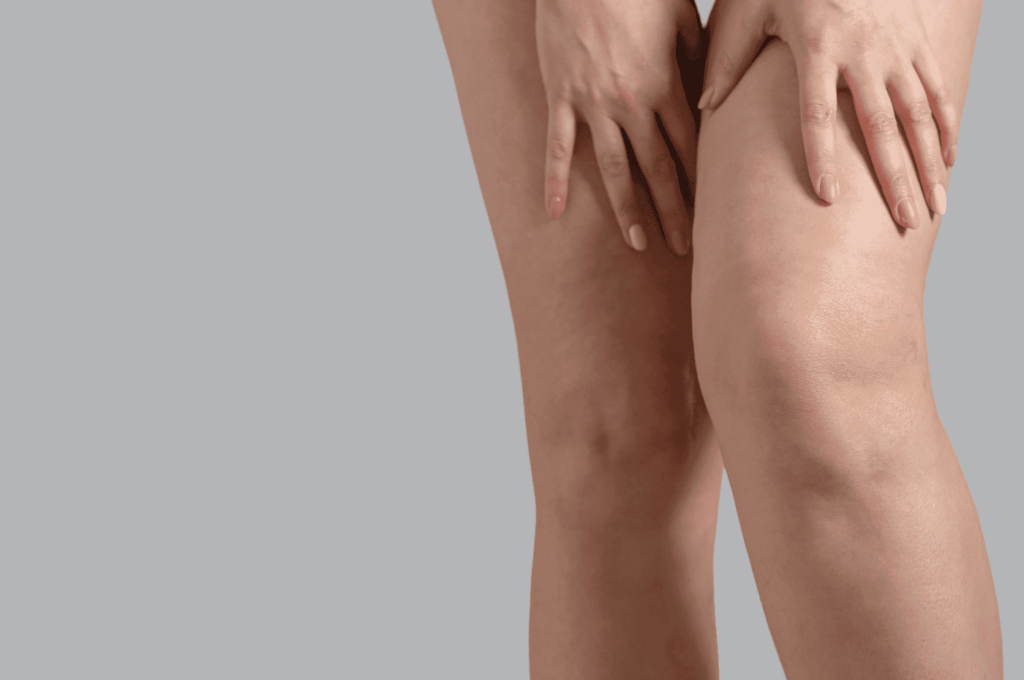
|
Spider veins are small, dilated blood vessels that appear close to the surface of the skin, often looking like red, blue, or purple webs. While typically harmless, they can sometimes cause discomfort or achy legs. Effective treatment options like sclerotherapy, laser therapy, and radiofrequency ablation can significantly improve their appearance and alleviate symptoms. If you’re ready to take control of your legs and explore treatment options, schedule a consultation with Advanced Vein & Laser Center today! |
Spider veins are small, dilated blood vessels that appear close to the surface of the skin, often looking like red, blue, or purple webs. While typically harmless, they can sometimes cause discomfort or achy legs. Effective treatment options like sclerotherapy, laser therapy, and radiofrequency ablation can significantly improve their appearance and alleviate symptoms. If you’re ready to take control of your legs and explore treatment options, schedule a consultation with Advanced Vein & Laser Center today!
Have you ever noticed those thin, red squiggly lines on your legs? They’re called spider veins, and they can be a real bother.
This blog cuts through the medical jargon to explain what spider veins are, why they show up, and how to get rid of them.
We’ll break down the simple reasons behind these unwanted and unsightly veins, from family genes to everyday habits. Then, we’ll explore different ways to treat them, so you can decide what’s best for you and get those legs feeling confident again!
But wait, there’s more! We’ll also share some easy tips to keep your legs healthy after treatment, so you can keep spider veins at bay for good.
What Are Spider Veins And What Causes Them
Spider veins, also known as telangiectasias, are small, dilated blood vessels that appear close to the surface of the skin. They are typically red, blue, or purple in color and can resemble a spider’s web or tree branches.
The exact cause of spider veins is not fully understood, but several factors are believed to contribute to their development.
These factors include:
Genetics: Spider veins may run in families, suggesting a genetic predisposition.
Hormonal changes: Fluctuations in hormone levels, such as those that occur during puberty, pregnancy, or menopause, can increase the risk of developing spider veins.
Pregnancy: The hormonal changes and increased blood volume during pregnancy can put added pressure on the veins, leading to the development of spider veins.
Obesity: Excess weight can put additional pressure on the veins, causing them to become enlarged and visible.
Prolonged standing or sitting: Jobs or activities that require long periods of standing or sitting can increase the risk of developing spider veins.
Medical conditions: Certain medical conditions, such as venous insufficiency or blood clotting disorders, can contribute to the formation of spider veins.
While spider veins are generally harmless and do not cause any serious health problems, many people seek treatment for cosmetic reasons or to alleviate discomfort, such as aching, burning, or itching in the affected areas.
What Are The Symptoms Of Spider Veins?
While spider veins are often a cosmetic concern, sometimes they can cause some uncomfortable sensations.
These symptoms aren’t always severe, but they can be a nuisance.
Here’s what to watch out for:
Aching or throbbing in the legs
Burning or itching in the affected areas
Swelling or heaviness in the legs
Restless legs
Cramping or muscle fatigue
Discomfort worsened by prolonged standing or sitting
If you experience any of these symptoms or are bothered by the appearance of spider veins, it is recommended to consult with a healthcare professional to discuss treatment options.
The Importance of Seeking Treatment
While spider veins are generally harmless and do not pose a serious health risk, there may be risks associated with leaving them untreated.
Not only do spider veins have the potential to lead to more serious circulatory dysfunctions, they are also a cosmetic concern which can compromise your self esteem.
Seeking treatment can offer several benefits:
Improved appearance: Spider vein treatment can significantly reduce or eliminate the appearance of spider veins, allowing you to feel more confident about your legs and overall appearance.
Increased comfort: Spider veins can sometimes cause discomfort, such as aching, burning, or itching. Treatment can alleviate these symptoms and improve your quality of life.
Prevention of complications: Although rare, spider veins can sometimes lead to more serious venous conditions, such as varicose veins or blood clots. Treating spider veins early on can help prevent the development of these complications.
Boost in self-confidence: Many individuals feel self-conscious or embarrassed about their spider veins. By seeking treatment and achieving smoother, clearer legs, you may experience a boost in self-esteem and body image.
It is important to note that spider vein treatment is a personal choice and should be done for your own well-being, not to meet societal standards or expectations. You should consult with a qualified healthcare professional to determine if treatment is right for you.
Effective Spider Vein Treatment Options
Several effective treatment options are available for spider veins. Most of them are minimally invasive and don’t require much down time.
A few of the most popular spider vein treatments include:
Sclerotherapy:
This is the gold standard treatment for spider veins and has been around for decades. It involves injecting a sclerosing solution directly into the affected vein using a tiny needle.
The solution irritates the lining of the vein, causing it to collapse and scar shut. Over time, the body reabsorbs the closed vein, making it fade from view.
Sclerotherapy boasts a high success rate for treating spider veins, with most patients seeing significant improvement after a few sessions.
This outpatient procedure requires minimal downtime and recovery.
Sclerotherapy is generally less expensive compared to other spider vein treatments.
Laser therapy:
This is a newer, non-invasive treatment option for spider veins. It uses concentrated beams of light to target the hemoglobin (the iron-rich protein that carries oxygen) in the affected veins.
The laser energy heats up the hemoglobin, damaging the vein wall and causing it to shrink and eventually disappear.
Laser therapy can target very small spider veins with high accuracy, minimizing the risk of damage to surrounding tissues.
This treatment often requires minimal to no anesthesia and is generally well-tolerated by patients.
You may see visible improvement in the treated spider veins within a few weeks.
Radiofrequency ablation:
This minimally invasive procedure uses radiofrequency energy to treat spider veins.
A thin catheter is inserted into the affected vein, and radiofrequency waves are emitted to heat the vein wall.
The heat damages the vein lining, causing it to seal shut and collapse. The body then reabsorbs the closed vein over time.
Radiofrequency ablation can treat a wider range of vein sizes compared to laser therapy, making it suitable for both spider veins and small varicose veins.
This treatment offers a high success rate for eliminating spider veins.
The results of radiofrequency ablation are typically long-lasting.
It’s important to consult with a healthcare professional to determine the most suitable treatment option for your specific case.
They will consider factors like the size and location of your spider veins, your overall health, and your desired outcome.
Benefits of Spider Vein Treatment
Beyond the cosmetic benefits of achieving smoother, more confident legs, spider vein treatment offers a range of advantages that can significantly improve your well-being.
Spider vein treatment offers several benefits, including:
Improved appearance: Spider vein treatment can significantly reduce or eliminate the appearance of spider veins, resulting in smoother, clearer legs.
Increased self-confidence: By improving the appearance of your legs, spider vein treatment can boost your self-esteem and body image.
Alleviation of symptoms: Spider veins can sometimes cause discomfort, such as aching, burning, or itching. Treatment can alleviate these symptoms and improve your quality of life.
Prevention of complications: Treating spider veins early on can help prevent the development of more serious venous conditions, such as varicose veins or blood clots.
Minimal downtime: Spider vein treatment is typically performed on an outpatient basis, meaning you can go home the same day. The procedure is relatively quick and minimally invasive, allowing you to resume your daily activities with little to no downtime.
Long-lasting results: While spider veins may not be completely curable, treatment can provide long-lasting results and significantly reduce their appearance.
It is important to have realistic expectations about the results of spider vein treatment.
While the treatment can greatly improve the appearance of your legs, it may not completely eliminate all spider veins or prevent the development of new ones in the future.
Your healthcare professional can provide more information about what you can expect from treatment.
Tips For Maintaining Healthy Legs After Treatment
After undergoing spider vein treatment, it is important to take care of your legs to maintain the results and promote overall leg health.
Your healthcare provider will give you instructions on how best to maximize your results.
Here are some tips:
Wear compression stockings: Your healthcare professional may recommend wearing compression stockings after treatment to help support the veins and improve blood flow. Follow their instructions regarding the type and duration of compression.
Stay active: Regular exercise, such as walking or swimming, can help improve circulation and strengthen the muscles that support the veins. Consult with your healthcare professional to determine the most suitable exercise routine for you.
Avoid prolonged periods of standing or sitting: If your job or daily activities require long periods of standing or sitting, try to take frequent breaks to move around and avoid prolonged pressure on the veins.
Maintain a healthy weight: Excess weight can put additional pressure on the veins, increasing the risk of developing spider veins or worsening existing ones. Follow a balanced diet and engage in regular physical activity to maintain a healthy weight.
Elevate your legs: Elevating your legs above heart level for short periods can help reduce swelling and promote better blood flow. Consider propping up your legs with pillows while resting or sleeping.
Practice good skincare: Keep your skin moisturized and protected from the sun to maintain its health and appearance. Avoid hot baths or showers and harsh soaps that can dry out the skin.
Follow your healthcare professional’s instructions: Your healthcare professional will provide specific post-treatment instructions tailored to your individual case. It is important to follow these instructions carefully to ensure optimal healing and results.
Remember, maintaining healthy legs is an ongoing process. Regularly monitor your legs for any changes or new symptoms and consult with your healthcare professional if you have any concerns.
By following these tips and incorporating them into your daily routine, you can help maintain the results of spider vein treatment and promote overall leg health.
Schedule a Consultation at Advanced Vein & Laser Center Today To Take Control of Your Vein Health!
Spider veins can be a nuisance, both aesthetically and physically. But you don’t have to live with them!
At Advanced Vein & Laser Center, our experienced team is dedicated to helping you achieve smoother, healthier legs. We offer a variety of effective spider vein treatment options, tailored to your specific needs and concerns.
Schedule a consultation today to discuss your spider veins and explore the treatment options that can empower you to feel confident and comfortable in your own skin.


